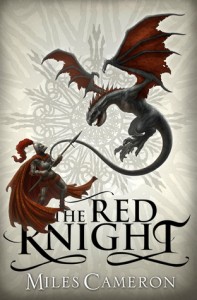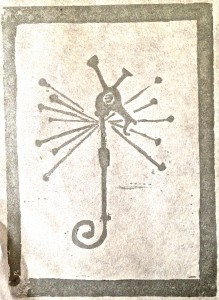
 In the past I’ve found the promotional bag of books from a con can vary widely in terms of quality. One treasure that emerged from my World Fantasy Convention bag, though, is THE RED KNIGHT by Miles Cameron. I’m about to send my copy off to a friend, and I thought I’d recommend it to other folks as well.
In the past I’ve found the promotional bag of books from a con can vary widely in terms of quality. One treasure that emerged from my World Fantasy Convention bag, though, is THE RED KNIGHT by Miles Cameron. I’m about to send my copy off to a friend, and I thought I’d recommend it to other folks as well.
In flavor, it reminds me a little of what I like about Joe Abercrombie – a nice grittiness to the characters, as well as a melange of viewpoints that end up weaving together coherently to deliver a story that pulls you along. The social structure feels medieval, full of knights and squires, but while noble by birth, most are not noble in nature. I like strong female characters in my fiction, and there’s plenty of them in here, including some older ones, which I appreciate. The fighting is nicely choreographed and realistic, without the description ever getting tedious.
It’s the usual some dark mystic force is invading sort of plotline, but it’s enjoyable and tense. I’m a fan of big fat fantasy novels, and this is both engaging and highly satisfactory, to the point where I’m eager to read the next, since THE RED KNIGHT is the first of a trilogy. The jacket says Miles Cameron writes historical fiction under another name, and I’m going to poke around and see if I can’t find his other work, since I enjoyed this so much.
...

Erin Morgenstern’s THE NIGHT CIRCUS was a terrific read and one that will delight fans of THE PRESTIGE and CARTER BEATS THE DEVIL. Lots of gorgeous and beautiful description of a highly evocative setting and the love story that plays out against it.
While on a visit to Baltimore recently, I was introduced to Joe Hill’s graphic horror novel, LOCKE AND KEY. I read the first one, and am looking forward to the rest.
THE PALACE JOB by Patrick Weekes was a terrific romp of a fantasy read, and is an Ocean’s Eleven type adventure played out against a fantasy setting.
Jonathan Wood’s NO HERO and YESTERDAY’S HERO reminded me of a less frenetic Charlie Stross. Another fun and frothy urban fantasy was Jennifer Willis’ VALHALLA.
Love Joe Lansdale, but I’m reading him slowly in order to spread out the cost of getting all the Hap and Leonard novels. September held THE TWO-BEAR MAMBO as well as a collection of short fiction, BUMPER CROP.
I go back every few years to read E.F. Benson’s Mapp and Lucia novels. Why doesn’t someone do a fantasy version of these? That would be so awesome.
THE WEIRD: A COMPENDIUM and THE APEX BOOK OF WORLD SCIENCE FICTION are both books that I am dipping into periodically, spacing them out so I can think about the stories, rather than absorb them all in one long read.
THE BANDIT KING by Lilith Saintcrow is a fantasy romance, the sequel to THE HEDGEWITCH QUEEN. I’ve yet to find a Saintcrow book that I haven’t enjoyed.
In nonfiction, I’ve been reading these:
...
I’m headed into the city this evening to hear John Scalzi read from Fuzzy Nation. I’ve loved the Little Fuzzy books (and I’ll note that there’s a bunch of his stuff free for e-readers) since discovering them as a teenager and found a book club edition of the first two this weekend at the thrift store. I’d forgotten what a tear jerker the first one is, and the anti-corporate message seems even more timely than usual. I haven’t read Fuzzy Nation yet, but I’m picking it up today and looking forward to it. I’m also fascinated by the idea that Scalzi’s written fan fiction – it opens up some interesting questions about that debate.
I recommend the first book for people working on learning how to create emotional depth, which a couple of writers have mentioned to me lately. Any book that has me welling up with tears is doing its job right in that regard. I’m taking my Writing F&SF class to this reading so they can be inspired by seeing a writer in action – maybe Scalzi will get them to cry (in a good way).
...
Dragons, dragons, dragons – so many writers have written about them in one form or another. Here’s ten books featuring dragons for fellow lovers of the form.
...
I blogged a couple of weeks ago about books I’d recommend for writers focusing on their craft. This time I’m choosing books that are handy to have on a nearby shelf, particularly books that help spark new ideas, whether it’s at the overall story or plot level, or bits that can be used to adorn a story, the tiny embellishments like filagree or the lines in the Book of Kells, because we can always use new idea, little shocks, a kick in the head that turns the world askew in a way that lets us see it more clearly.
...
Tired of the usual stuff? Here’s five fantasy classics that you may have missed.
Jirel of Joiry, by C. L. Moore. If you love Red Sonja, Jirel is the heroine for you, worthy of company with Conan or Imaro. Indiana-born Moore was one of the first women to write in the sword and sorcery genre.
Tomoe Gozen, by Jessica Amanda Salmonson. Another strong woman is embodied in Tomoe Gozen, a samurai in the first of a trilogy set in a richly-realized and fabulous 12th century Japan.
Unquenchable Fire by Rachel Pollack. Beautiful and ornate, set in an alternate America that seems sadly unlikely, this is a fabulous take on spirituality today.
Monday Begins on Saturday, by Arkadi and Boris Strugatski. A young computer programmer is recruited for a Russian Institute devoted to the paranormal in a book that’s more Office Space than X-Files. One of my top ten favorite books of all time.
Green Phoenix, by Thomas Burnett Swann. Swann is sadly neglected and all of his books are worth picking up, but this is one of the lovelier ones. He does more interesting things with classic mythology than most authors.
...
When I’m teaching, I do bring some books to class in order to point students toward them. I don’t think books are a substitute for the act of writing, but they can help focus and direct your practice and give you a list of things to work on that might not otherwise occur to you. Here’s a list of my top ten for speculative fiction writers focusing on their craft. I was sad to find some not available on the Kindle, but where possible, I’ve pointed to the e-version.
2016 addendum! I still stand by all these, but here are five more:
Million Dollar Outlines
Storyteller by Kate Wilhelm
talk the Talk: A Dialogue Workshop for Scriptwriters by Penny Penniston
The Three Jaguars: A Comic about Art, Business, Life by M.C.A. Hogarth
Wonderbook: The Illustrated Guide to Creating Imaginative Fiction by Jeff VanderMeer. Worth it just for the pretty illustrations and marvelous charts produced by Jeremy Zerfoss in collaboration with VanderMeer, but also jam-packed with good and interesting writing advice that I have found best absorbed in small chunks, dipping into the book now and again for inspiration.
...
Want access to a lively community of writers and readers, free writing classes, co-working sessions, special speakers, weekly writing games, random pictures and MORE for as little as $2? Check out Cat’s Patreon campaign.

"(On the writing F&SF workshop) Wanted to crow and say thanks: the first story I wrote after taking your class was my very first sale. Coincidence? nah….thanks so much."

“Aardvark says moo,” says the clown, handing over the balloon animal.
My overly precocious kid squints her eyes. “No they don’t.” She folds her arms. No eight year old should be that definite about anything. Whatever happened to the idea of childish sense of wonder?


This site is protected by reCAPTCHA and the Google Privacy Policy and Terms of Service apply. This site is a participant in the Amazon Services LLC Associates Program, an affiliate advertising program designed to provide a means for sites to earn advertising fees by advertising and linking to Amazon.com.